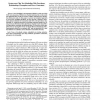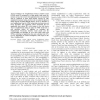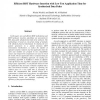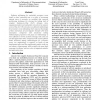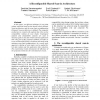TCAD
2002
14 years 6 months ago
2002
Test scheduling is an important problem in system-on-a-chip (SOC) test automation. Efficient test schedules minimize the overall system test application time, avoid test resource c...
ICCAD
1995
IEEE
14 years 10 months ago
1995
IEEE
Implementing a built-in self-test by a "test per clock" scheme offers advantages concerning fault coverage, detection of delay faults, and test application time. Such a ...
EURODAC
1995
IEEE
14 years 10 months ago
1995
IEEE
We present a procedure to generate short test sequences for synchronous sequential circuits described at the gate level. Short test sequences are important in reducing test applic...
ATS
2001
IEEE
14 years 10 months ago
2001
IEEE
Testing embedded cores in a System-on-a-chip necessitates the use of a Test Access Mechanism, which provides for transportation of the test data between the chip and the core I/Os...
DDECS
2009
IEEE
14 years 10 months ago
2009
IEEE
Although the Neighborhood Pattern Sensitive Fault (NPSF) model is recognized as a high quality fault model for memory arrays, the excessive test application time cost associated wi...
DATE
1999
IEEE
14 years 11 months ago
1999
IEEE
In this paper, new and efficient BIST methodology and BIST hardware insertion algorithms are presented for RTL data paths obtained from high level synthesis. The methodology is ba...
DFT
2002
IEEE
14 years 11 months ago
2002
IEEE
Conversion of the flip-flops of the circuit into scan cells helps ease the test challenge; yet test application time is increased as serial shift operations are employed. Furthe...
DATE
2002
IEEE
14 years 12 months ago
2002
IEEE
Software self-testing for embedded processor cores based on their instruction set, is a topic of increasing interest since it provides an excellent test resource partitioning tech...
ATS
2002
IEEE
14 years 12 months ago
2002
IEEE
In this paper, we present a technique for reducing the test length of counter-based pseudo-exhaustive built-in self-testing (BIST) based on width compression method. More formally...
VTS
2003
IEEE
15 years 4 days ago
2003
IEEE
In this paper, an efficient technique for test data volume reduction based on the shared scan-in (Illinois Scan) architecture and the scan chain reconfiguration (Dynamic Scan) arc...
